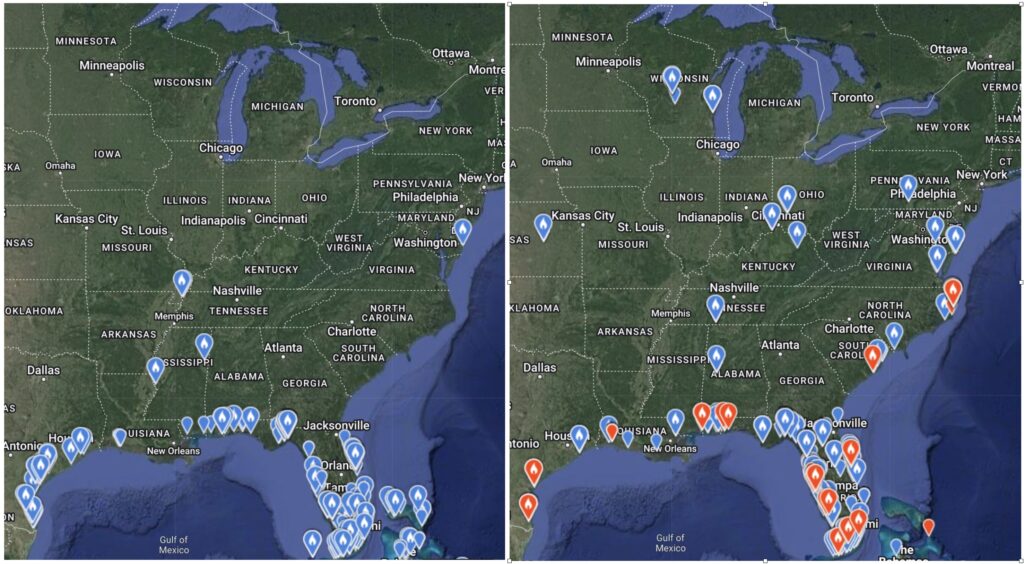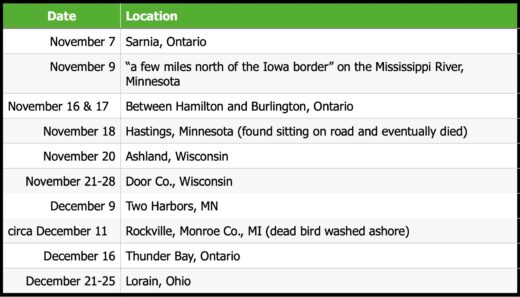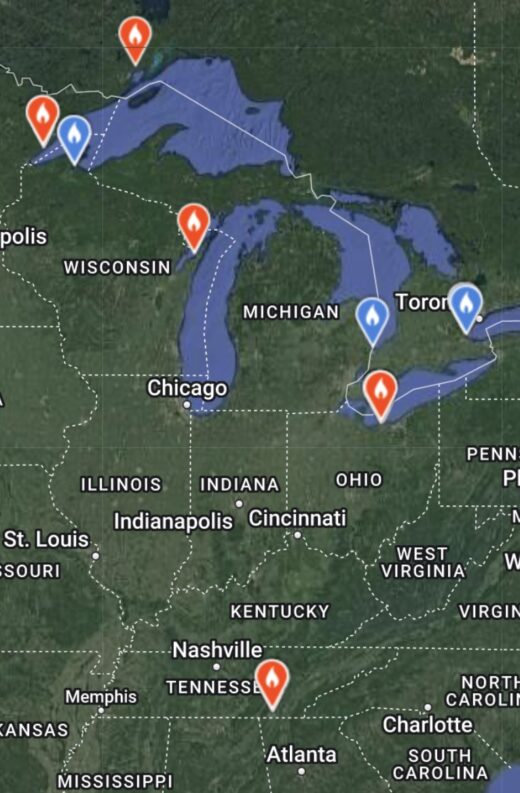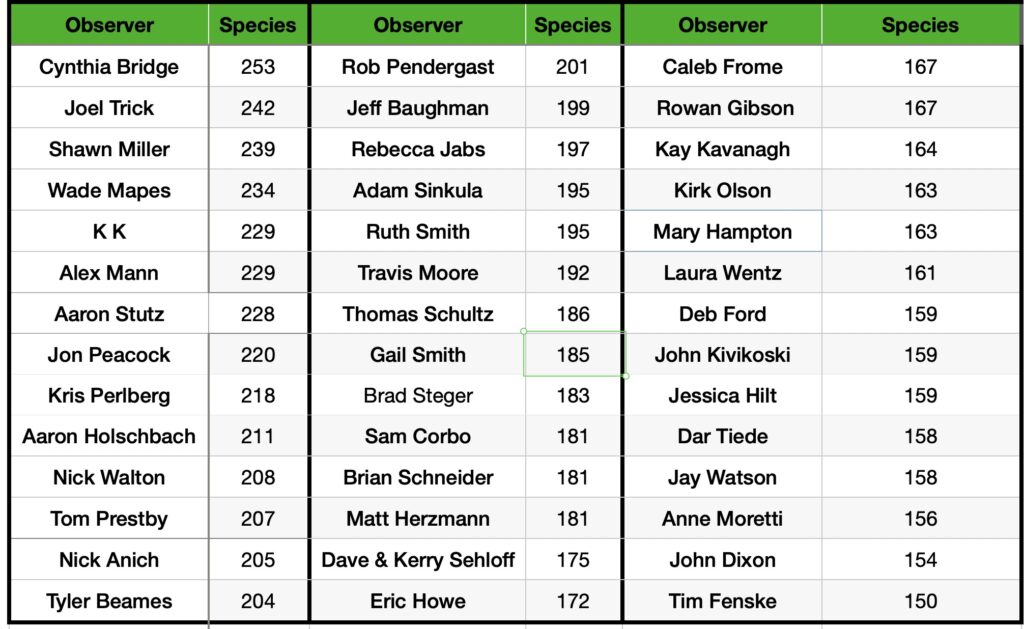2023 Wisconsin eBird Year in Review

eBirder Effort
Once again Wisconsin set a new record for checklist submissions. After pushing past 200,000 checklists in 2022, submissions surpassed the 220,000 mark in 2023. As usual the population centers of Dane and Milwaukee counties contributed nearly 25% of all checklists. The top twelve counties contributed over half of all complete checklists, while the bottom twelve counties contributed just over 2%.
Dane and Milwaukee counties also topped the species totals list (as always). The slots behind these two counties are more variable. This year Sauk and Door County birders had excellent years and occupied the third and fourth positions. Door added eleven new species to its all-time county eBird list and Sauk birders added nine!
The Birds
Each year we use this space to feature rare and notable Wisconsin birds. The 356 species observed statewide tied an eBird era record set just last year. Two species were added to the state list—American Flamingo and Flame-colored Tanager. It was a year with significant rarities sprinkled throughout. The steady increase in effort and statewide coverage from eBirders was crucial to locating these rarities.
Southern Birds
2023 had Wisconsin birders seeing pink! The most charismatic species found in the state–species that non-birding strangers would start unprompted conversations about–were incredibly and electrifyingly pink. Pink is not a common color in the state’s avifauna. Male House Finches can be pinkish with dirty brown tones. Purple Finches are not quite purple, but they are not quite pink either. The rose-colored breast of a Rose-breasted Grosbeak is arguably closer to red than pink. This leaves us with the odd gull here or there with faint pinkish underparts, but I’ve yet to meet a non-birder that described gulls as “charismatic”.
So in this the year of the Barbie movie, what was the first pink bird to penetrate pop culture in Wisconsin? It was a Roseate Spoonbill–not seen in the state since 1845 (Rock County). Wisconsin’s celebrity Spoonbill was first spotted on July 26th at Cat Island Causeway in Brown County. Present for only a short time, a few birders were able to see the bird before it departed. Later presumably the same bird was observed near Escanaba, MI before conveniently reappearing in Wisconsin on July 29th at Ken Euers Wetland Preserve, Brown County. The bird showed well for many, was covered by local news, radio, and newspapers, and the story even ran in a few national newspapers. On August 4 the bird departed Green Bay.
The story does not end there. On August 12th a Roseate Spoonbill was spotted and photographed on the Crawfish River in Jefferson County by different groups of paddlers. The next day the bird was gone, but on August 29th it was relocated at Lake Mills SWA–Zeloski Marsh also in Jefferson County. Where did it hide for over two weeks? The bird was last seen flying southwest over Zeloski Marsh. What was likely this same bird was relocated near Dubuque, IA on September 6th, then near Mississippi Palisades State Park, IL on September 20.
Despite the absence of records for almost 180 years, Roseate Spoonbill was expected in the state. Why? Roseate Spoonbills engage in a behavior called post-breeding dispersal–essentially they wander significant distances after breeding in search for food. This is a behavior particularly common in herons and egrets. Late summer Roseate Spoonbills records have been creeping north over the decades. In 2023 this pattern accelerated with Wisconsin, Iowa, Illinois, Michigan, Ontario, Indiana, Ohio and New York among the northernmost states or provinces with records.
Little did we know that Roseate Spoonbill was just the opening act. On September 22nd five American Flamingos were spotted along Lake Michigan in Port Washington.
News spread slowly at first. but by early afternoon crowds were forming on the beach. At least three local news crews were on the scene and the story was eventually picked up by national media. After school let out, families from across Metro Milwaukee poured into Port Washington. For many the closest parking was 1.5 miles away and by late afternoon hundreds of people were on the beach. The event concluded a bit after 5 P.M. when the birds flew south–though notably some observers felt the birds eventually banked to the west.
What brought the birds here? This was not post-breeding dispersal–Flamingos do not breed in the United States. Flamingos have a very limited pattern of vagrancy away from Florida and the Gulf Coast. In most cases, out-of-range flamingos are rightfully considered escapees, but not this time. Instead the late August passage of Hurricane Idalia over American Flamingo breeding areas in Cuba and the Yucatan brought incredible numbers of these birds to the United States.
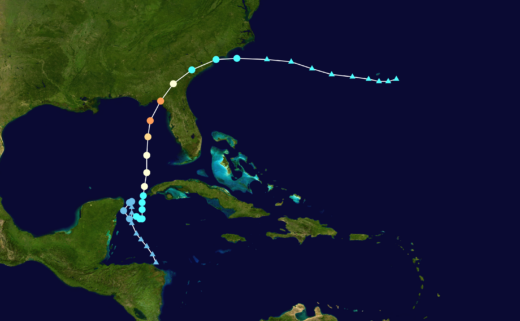
HikingHurricane – Created by HikingHurricane using Wikipedia:WikiProject Tropical cyclones/Tracks. The background image is from NASA. Tracking data is from NHC. Public Domain
By early September it was clear Flamingos were making an unprecedented northern incursion with records from Ohio, Tennessee, Kentucky and Indiana. Florida (where wild Flamingos are rare) had widespread reports and exceptional high counts. A few states further north on the Atlantic seaboard also got their first flamingo records. The pulse of extralimital midwestern records paused after early September–making the Wisconsin records and a later Saginaw Bay, Michigan record from October all the more exceptional.
After the Port Washington birds departed, conventional wisdom said these birds would materialize further south along Lake Michigan. The flamingos opted for a different path, disappointing Illinois birders, and shocking some Wisconsin River boaters by landing near Dell Prairie just a day after leaving Port Washington. About a week later the birds settled in near Lake Petenwell and stayed until October 8th–cooperating for many birders.
Flamingos were not the only species caught up in Hurricane Idalia. This Royal Tern split time between Wisconsin and Minnesota waters was likely transported by the same weather system.
The rarest ibis in Wisconsin is White Ibis–the first in the state since 2013. This bird was more likely a product of post-breeding dispersal than the hurricane–though both could have contributed to its brief stay in Door County.
All three expected kite species were present this summer. Swallow-tailed Kites were reported in Columbia, Dodge, Sheboygan, and Bayfield counties. On September 5 Bayfield County birders observed the Swallow-tailed Kite, 6 Swainson’s Hawks, and a Western Kingbird. The yard hosting these birds also had a Lark Bunting in both the spring and fall!
A White-tailed Kite lingered in Door Country for months.
A Black Vulture was unexpected in Bayfield County. It lingered for several days in a vulture roost that had a Black Vulture in 2015.
Vagrant flycatchers are expected in fall. Wisconsin’s third record of Tropical Kingbird came in October. Notably all Wisconsin records of this species come from Ashland and Bayfield Counties.
Hot Limpkin Summer
Counties with Limpkin records before 2022? Zero. Counties with Limpkin records by the end of 2022? Three. Counties with Limpkin records by the end of 2023? Twenty-seven! This year we truly had a “Hot Limpkin Summer”. This species is rapidly expanding its range due to the spread of invasive snails. Wisconsin birds are frequently observed feeding on snails and freshwater mussels. This is a rather abrupt and recent phenomenon, prior to 2017 United States records of Limpkin were almost entirely restricted to Florida.
Limpkins lingered beyond the summer. At least two were present in late November and one was even reported in December! How often has this species enountered snow? At least one lingering bird did not fare well in a November snowstorm, this Rock County bird eventually collapsed and was taken to a wildlife rehabilitation facility.
There is no indication the invasion will slow down. Time will tell what the future holds for this species and eBird is the best way to track these changes. Two birds observed together in Brown County beg the question, is breeding next?
Western Birds
Extremely strong winds out of the west in late April brought in an incredible wave of western vagrants. Most notable was Wisconsin’s first ever record of Flame-colored Tanager on April 29. This record was truly exceptional. Outside of this bird, the northernmost records come from the Chiricahua Mountains in Southeast Arizona. The only other records in the United States come from Arizona and Texas.
The arrival of the Flame-colored Tanager was foreshadowed by a visit from another southwestern passerine–the state’s first chaseable Painted Redstart in Sauk County on April 23.
The same weather system likely brought Wisconsin’s sixth record of Band-tailed Pigeon to Marathon County on April 24th.
Another western rarity was this Black-throated Gray Warbler in Racine County found on the same day as the Flame-colored Tanager.
After the April surge, the remaining remarkable western vagrants mostly occurred in October. They included the states’s ninth Vermillion Flycatcher in Door County.
On October 21 a very cooperative Clark’s Nutcracker was found at Nine Springs Natural Area in Dane County–the first time this species was chaseable on public lands in Wisconsin.
On October 22 a Ferruginous Hawk was observed at Horicon NWR–Auto Tour and Trails furnishing the state’s 18th record.
The last rarity of the year was an incredibly cooperative and partially pink(!) Gray-crowned Rosy-Finch at Devil’s Lake State Park in Sauk County. The bird was often found fearlessly feeding near of the main trail. Many birders described feeling transported “Out West” as they hiked up the quartzite bluff accompanied not only by the Gray-crowned Rosy-Finch, but also Townsend’s Solitaires and Golden Eagles. The latter two species are nearly annual at the park.
Northern and Arctic Birds
In late May a Ross’s Gull was at Wisconsin Point in Douglas County. This is the state’s third record. Regionally there was also a Lake Michigan bird near the Illinois/Indiana border in mid-March.
As temperatures and Limpkin records cooled, Great Lakes Ancient Murrelet records started to heat up. Wisconsin records came from Ashland and Door Counties. The state’s first records since 2007 and the first ever chaseable bird(s) of this species. Wisconsin has records for three different alcid species–Long-billed Murrelet, Dovekie, and Ancient Murrelet.
Records in Ontario and Minnesota foreshadowed the arrival of the Wisconsin bird(s).
2023 was an atypical year for this species. In 2022 the easternmost record of Ancient Murrelet in North America came from Yellowstone National Park!
Eurasian Birds
Aside from now expected annual visitors like Ruff and Eurasian Wigeon, the only notable Eurasian vagrant was a Tufted Duck at Wisconsin Point in Douglas County.
The Numbers
2023 Species by County
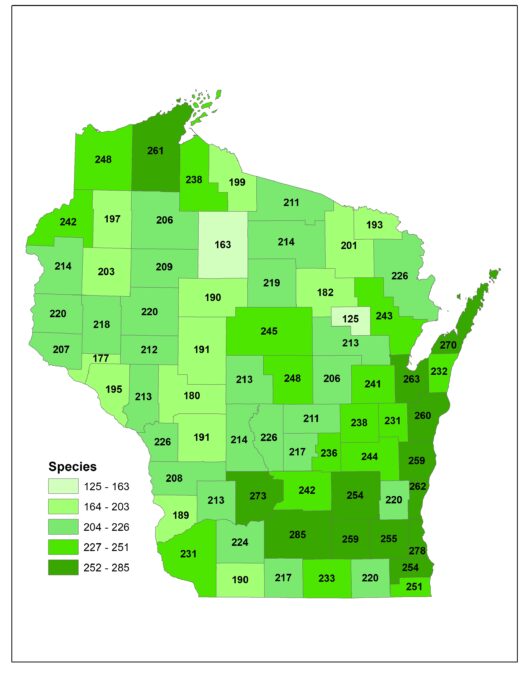
2023 Checklists by County
The Birders
Top County Totals – 2023 Species (Threshold 200):
In 2023, 155 birders matched or exceeded the 200 species threshold. This surpasses the previous high of 148 set in 2022. As always Dane County dominates the chart occupying 52 slots. The all time high in the eBird era is Neil Gilbert’s 286 species in Dane County (2020). Well done county eBirders! Congratulations to K K for topping this year’s list.
The 2023 Wisconsin Local Patch Challenge
In 2023, 15 birders surpassed the 200 species threshold in their home-centered patches. This is the second highest total in the short history of the Patch challenge. The high was 16 in 2022.
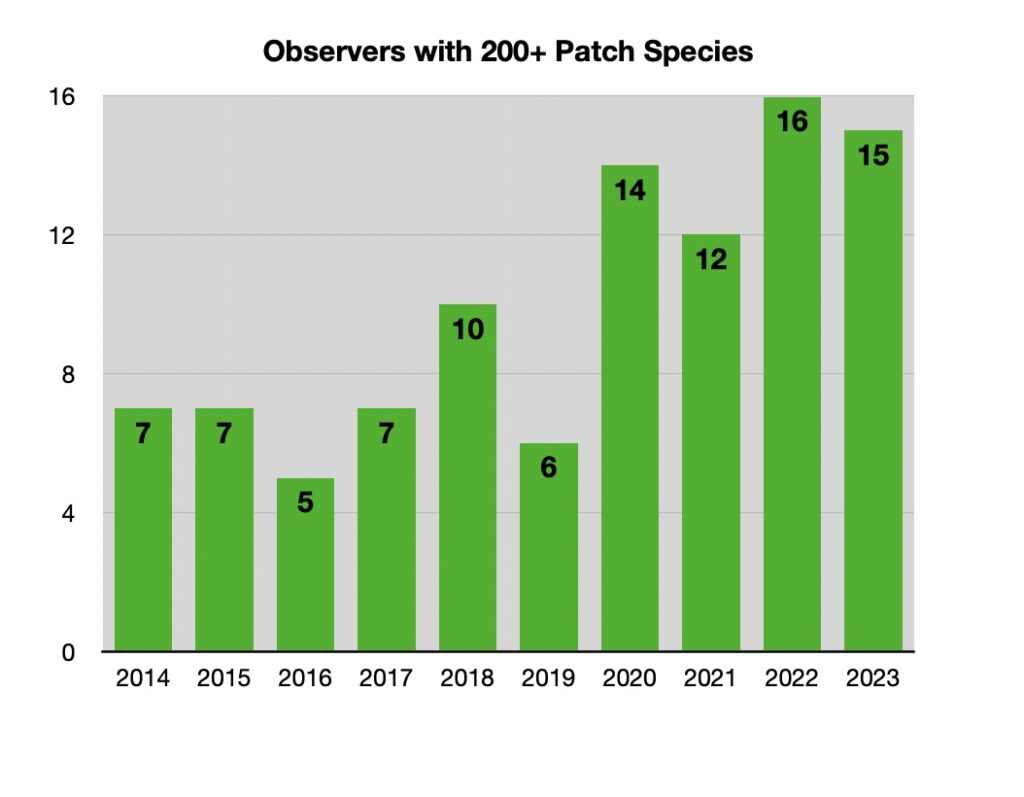 For the uninitiated the Wisconsin Local Patch Challenge is a way to standardize patch birding. Each patch listed is a 7.5 mile radius circle (or smaller) centered at the birder’s home. Congratulations to Cynthia Bridge for the year’s highest total!
For the uninitiated the Wisconsin Local Patch Challenge is a way to standardize patch birding. Each patch listed is a 7.5 mile radius circle (or smaller) centered at the birder’s home. Congratulations to Cynthia Bridge for the year’s highest total!
Below are the 2023 Wisconsin Local Patch Challenge Participants and their year totals (threshold 150 species):
Errors and omissions are unintentional. Corrections are welcome. Data was pulled on 12/31/2023 at 11:44AM.
Aaron Stutz
agstutz@sbcglobal.net



